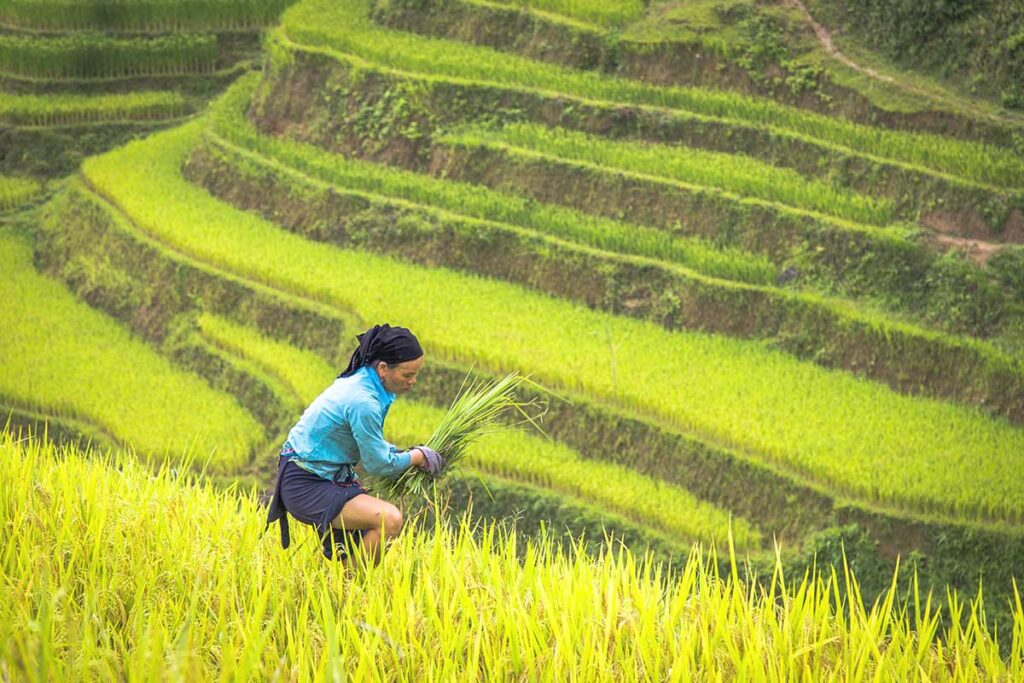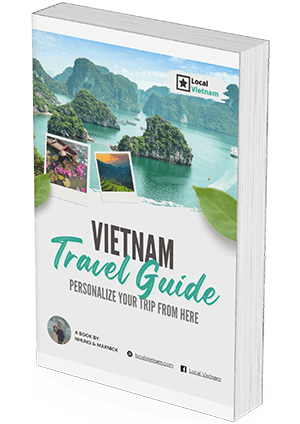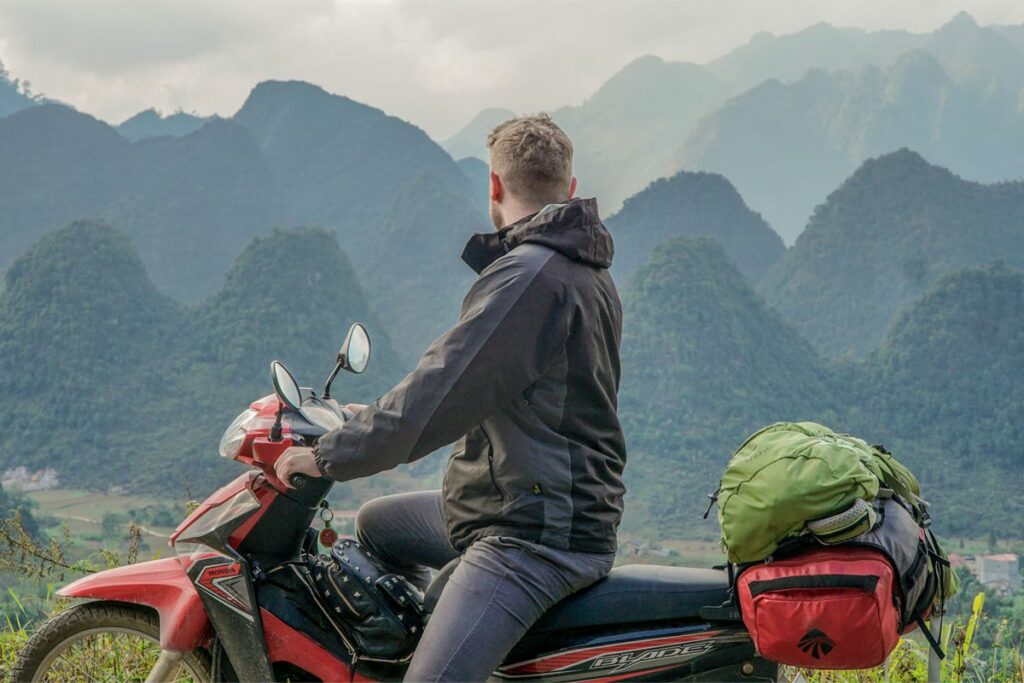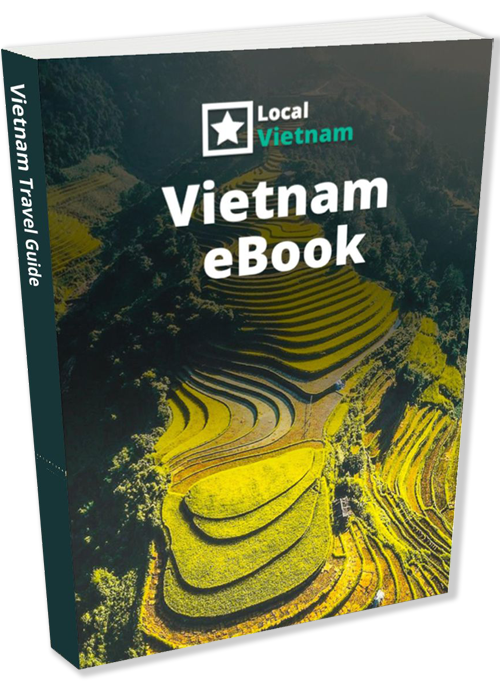Understanding the climate of Ha Giang
Ha Giang, located in the northernmost region of Vietnam near the Chinese border, is defined by its mountainous terrain and breathtaking landscapes. Its altitude and rugged geography create a cooler and more varied climate compared to Vietnam’s lowlands. While the region experiences four distinct seasons, the higher altitudes ensure that temperatures remain more moderate year-round.
The Ha Giang Loop spans multiple districts, each with its own microclimate. Lower areas like Ha Giang City are generally warmer and more humid, while higher-altitude regions, such as Dong Van and Meo Vac, are significantly cooler, particularly in the mornings and evenings. This diversity means travelers can experience a range of weather conditions within a single trip.
Rain Forecasts in Ha Giang
Rain forecasts for Ha Giang often indicate a chance of rain rather than all-day downpours. Due to the mountainous terrain, rainfall is highly localized, meaning one part of the loop could be sunny while another experiences a short, heavy shower. These rains are typically brief and followed by clear skies, allowing travelers to continue exploring without major interruptions.
Weather in Ha Giang in September
September in Ha Giang marks the end of the rainy season and the beginning of the dry season, creating a mix of light rain and clear skies. Daytime temperatures in the lower valleys, such as Ha Giang City, range from 27°C to 30°C (81°F to 86°F), while higher-altitude areas like Dong Van and Meo Vac are cooler, with temperatures between 22°C to 25°C (72°F to 77°F). Mornings and evenings in the mountains can feel crisp, with temperatures dipping to around 18°C to 20°C (64°F to 68°F). Weather can vary drastically day by day; one day might be sunny and warm, while the next could bring a brief rain shower and cooler conditions.
Rainfall in September is less frequent compared to the peak rainy months of July and August. When it does rain, it’s typically short and occurs in the afternoon, leaving mornings ideal for exploration. Clouds are less likely to obstruct views compared to the winter months, and the landscape is still lush and green from the rainy season. This month also enjoys some of the clearest skies of the year, offering plenty of sunshine and excellent conditions for photography and outdoor activities.
Is September a Good Time to do the Ha Giang Loop?
Yes, September is an excellent time to experience the Ha Giang Loop. This month offers spectacular views of golden terraced rice fields during the harvest season, making it one of the most visually rewarding times to visit. The weather is transitioning to the dry season, with fewer rain showers, clear skies, and pleasant temperatures that are ideal for motorbike travel and outdoor exploration.
However, there are still some challenges to keep in mind. While rains are less frequent, sudden afternoon showers are still possible, so having rain gear is essential. Road conditions can be slippery in areas that have recently experienced rain, and caution is needed on steep or unpaved sections. The weather can also vary between valleys and high-altitude areas—warm in the valleys but cooler in the mornings and evenings at higher elevations. Planning your days to start early is important to make the most of the clearer mornings and to avoid potential late-afternoon rain.
Highlights of Ha Giang in September
September is a stunning month to explore Ha Giang, as the region bursts with golden hues of terraced rice fields during the harvest season. The pleasant weather and reduced rainfall make it ideal for outdoor activities like exploring the Ma Pi Leng Pass or venturing off the main loop to quieter areas like Du Gia or Hoang Su Phi. Below are some of the must-see highlights in Ha Giang during September.
1. Seeing the golden terraced rice fields
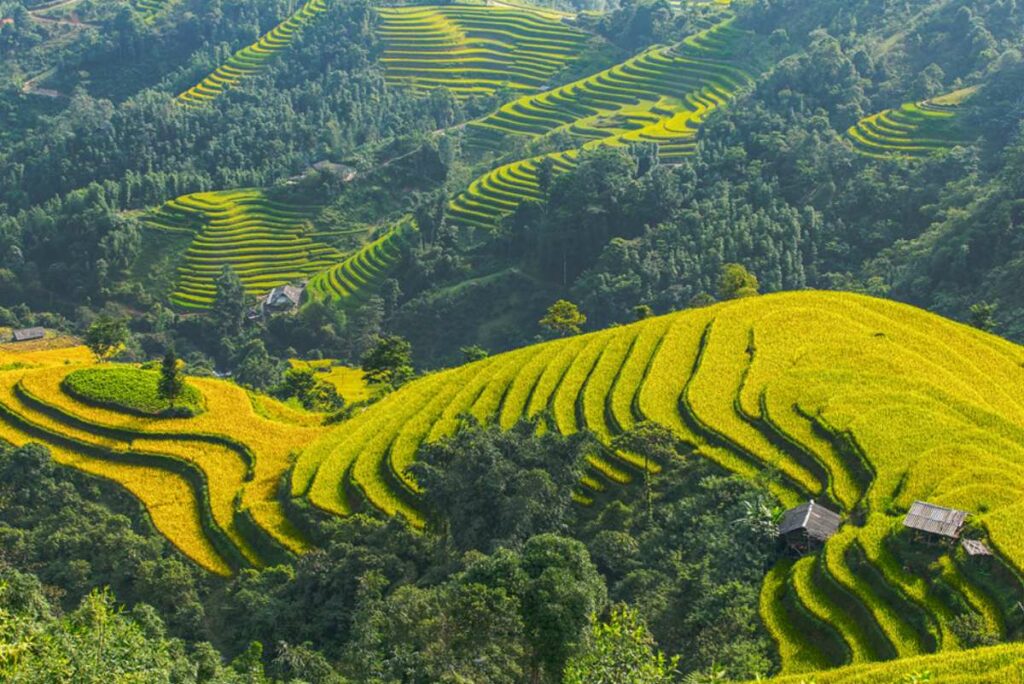
September marks the peak of the harvest season, transforming Ha Giang’s terraced rice fields into golden landscapes. Areas like Hoang Su Phi (not along the route of the Loop), Dong Van, and Quan Ba offer breathtaking views as ethnic communities work on the fields, providing an authentic glimpse into rural life. This is also a photographer’s dream, with the combination of golden rice fields and lush mountain backdrops creating incredible photo opportunities.
2. The Ma Pi Leng Pass highlights
The Ma Pi Leng Pass is a must-see in any month, but September offers some of the clearest skies for expansive views of the surrounding karst mountains and the Nho Que River gorge. The cooler, dry conditions make it an excellent time to stop at Ma Pi Leng Sky Pass or take a boat trip along the river for a different perspective of this iconic route.
3. Trekking in Hoang Su Phi
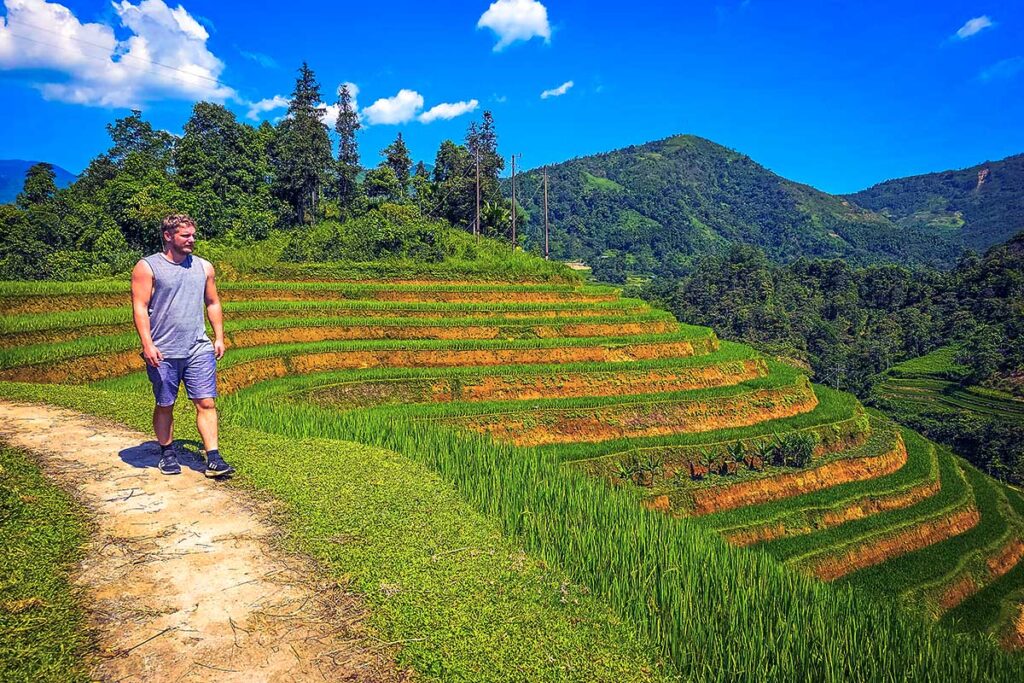
Hoang Su Phi, located off the main loop, boasts some of the most beautiful terraced rice fields in Vietnam. September is an ideal time for trekking here, as the fields are golden and the weather is pleasant. While it takes extra time to visit, the stunning views and serene atmosphere make it worth spending two to three days exploring this less-visited gem.
4. Discovering Du Gia
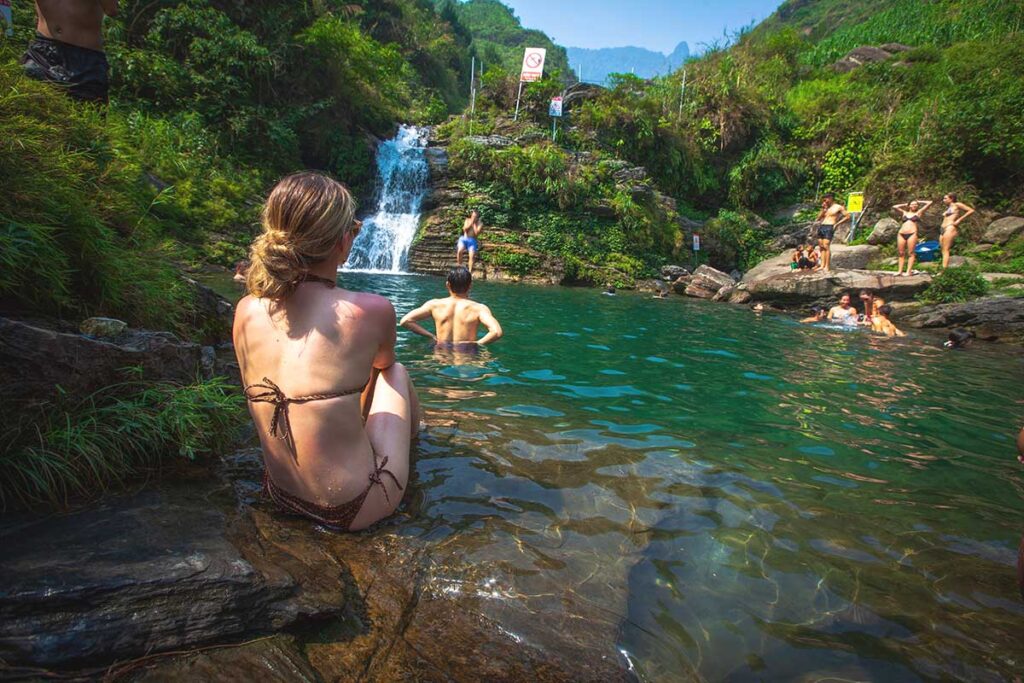
Du Gia is a tranquil commune surrounded by terraced rice fields, which are at their best in September as the harvest season begins. The stilt houses and traditional lifestyle add to its charm, and the nearby Du Gia Waterfall offers a refreshing escape. The mix of golden fields and peaceful rural life makes Du Gia a must-visit for travelers seeking quieter stops along the loop.
5. Exploring ethnic life
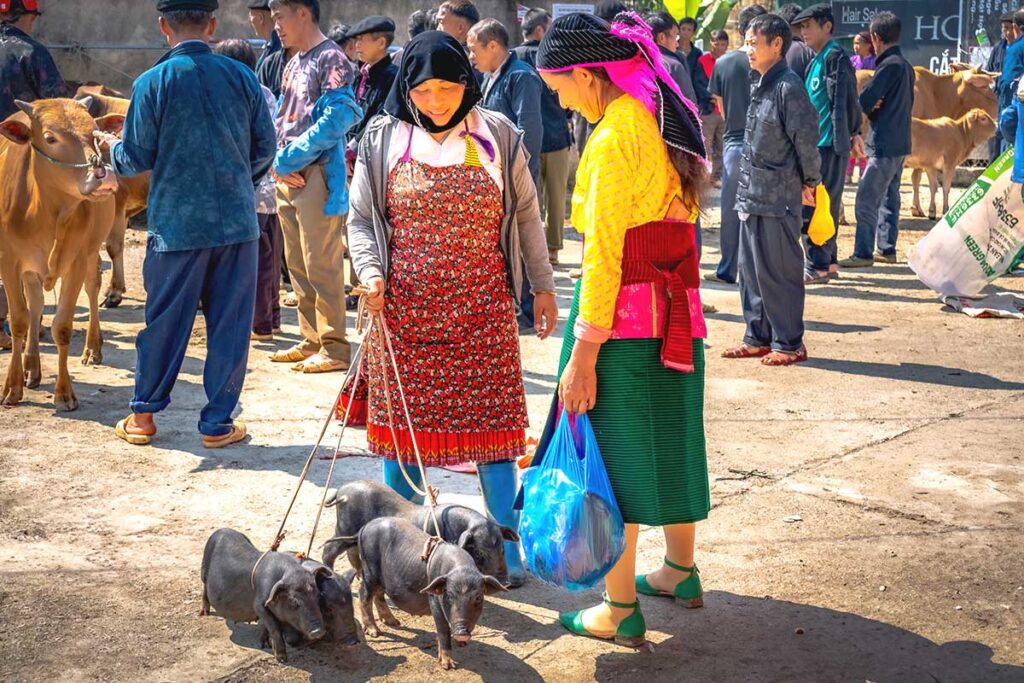
Ethnic communities remain one of the highlights of Ha Giang, regardless of the month, but September provides a unique opportunity to see the rhythm of daily life during the rice harvest. Markets in Dong Van and Meo Vac are vibrant with activity, and villages buzz with the sounds of farming and traditional practices. The cultural diversity and vibrant clothing of the ethnic groups make every interaction a rich experience.
Travel tips for the Ha Giang Loop in September
September is one of the best months to travel the Ha Giang Loop, with pleasant weather and stunning golden landscapes. However, preparation is key to making the most of your trip and avoiding potential challenges. Below are travel tips tailored for this month to help you plan your adventure.
Car or motorbike?
Choosing between a car and a motorbike depends on your comfort level, sense of adventure, and the weather conditions.
In September, the weather is nearly perfect for a motorbike trip. With reduced rainfall and cooler temperatures, it’s a great time to enjoy the freedom of riding and immersing yourself in the scenery. However, since there may still be occasional light rain, a lightweight rain jacket is a must. Driving your own motorbike is a fantastic option if you have experience and a valid license. Alternatively, riding on the back of a local guide’s motorbike ensures safety and allows you to fully enjoy the views without worrying about navigating the roads.
A car is an excellent choice for travelers who prefer comfort or are concerned about road conditions after rain. While you might miss some of the thrill and flexibility of a motorbike, a car lets you follow the same scenic route while avoiding wet roads or muddy trails. It’s also ideal if you’re traveling with family or a group.
Heating / cooling at accommodations
In September, the mild weather means heating or cooling options are generally not a major concern. At lower altitudes, such as Ha Giang City, it may feel slightly warm in the evenings, so accommodations with fans or open windows are usually sufficient. In higher-altitude areas like Dong Van and Meo Vac, nights can get cooler, a light jacket might come in handy. Many local homestays don’t have air conditioning or heating, but this is rarely an issue during this time of year. If you’re sensitive to temperature changes, it’s worth double-checking your accommodation’s amenities before booking.
What to wear on a motorbike
Riding a motorbike in September is comfortable, but choosing the right clothing ensures you’re prepared for varying conditions.
- Wear long sleeves to protect your skin from the sun, even if it’s not intensely hot. The added layer also helps with wind and light rain.
- Carry a lightweight jacket that can protect you from brief showers or slightly cooler temperatures at higher altitudes.
- Use sunglasses for both sun and dust protection.
- Pack a rain cover for your luggage and a small waterproof bag for valuables like your phone, wallet, and camera.
Essentials to prepare
Besides your usual packing for a multi-day trip, here are some items that are particularly useful for September:
- Rain gear: A lightweight rain jacket and pants for sudden showers.
- Sun protection: Sunscreen and sunglasses, as the sun can still be strong in September.
- Portable charger: Keep your devices charged, especially if you’re relying on offline maps.
- Waterproof phone case: Sudden rains can soak your gear quickly.
- Mosquito repellent: Useful for lower-altitude areas where mosquitoes are more common after rain.
Start early
In September, starting your day early is the best way to make the most of the clear mornings and avoid potential afternoon showers. Early starts also give you more time to explore highlights like terraced rice fields or the Ma Pi Leng Pass without feeling rushed. However, keep in mind that mornings in higher-altitude areas may be cooler, so dress in layers to stay comfortable as the day warms up.
